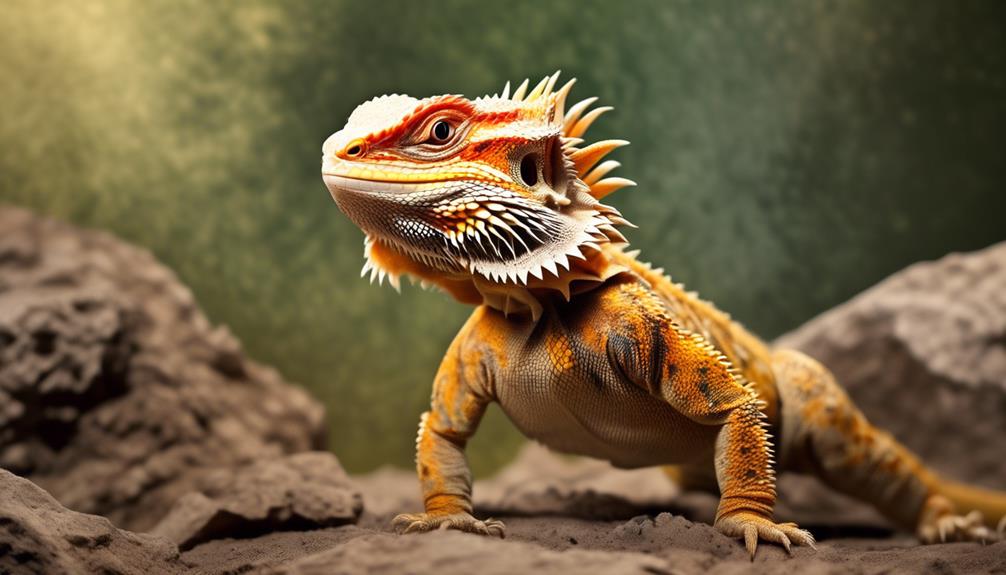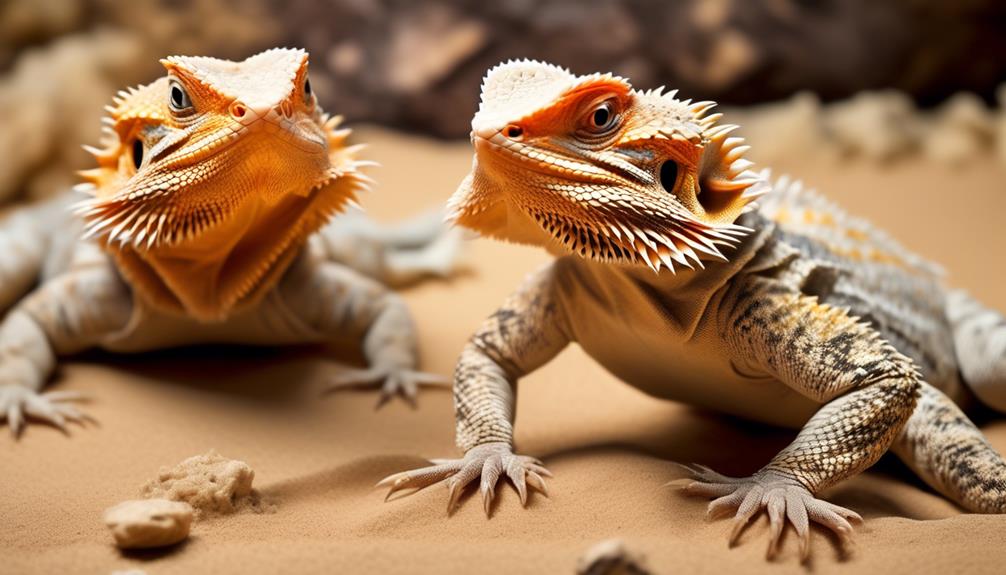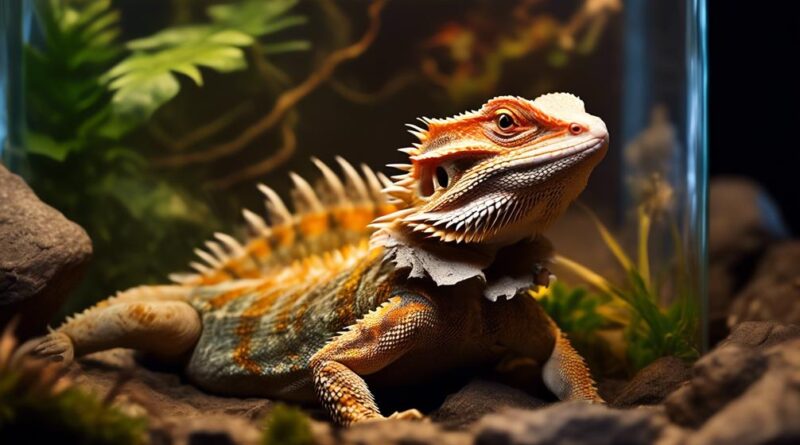Managing Territorial Tendencies in Bearded Dragons
If you've ever felt the prickly heat of territorial behavior, you know how intense it can be.
Bearded dragons, too, have their own ways of asserting their space and dominance.
Understanding and managing their territorial tendencies is crucial for their well-being and your peace of mind.
From recognizing the signs of territorial aggression to implementing effective training techniques, there are numerous strategies to explore.
But how can you navigate this complex aspect of bearded dragon behavior?
Let's uncover the key insights and practical tips that can help you create a harmonious environment for both you and your scaly companion.
Understanding Territorial Behavior
Understanding territorial behavior in bearded dragons is crucial for their proper care and handling. Bearded dragons, like many reptiles, exhibit territorial tendencies as a natural part of their behavior. This behavior is particularly prominent in male bearded dragons, which often display territorial dominance as they mature. When understanding territorial behavior, it's important to consider behavior modification techniques to ensure the well-being of your bearded dragon.
Territorial dominance is a key aspect of bearded dragon behavior. Male bearded dragons, in particular, may become territorial as they mature. They may exhibit aggressive behaviors such as head bobbing, arm waving, or even biting to establish dominance and defend their territory. Understanding these behaviors is essential for providing a suitable environment for your bearded dragon.
Behavior modification can be utilized to manage territorial tendencies in bearded dragons. By creating a spacious and enriched habitat, providing separate feeding and basking areas for multiple dragons, and minimizing direct visual contact between them, you can help reduce territorial behaviors. Additionally, positive reinforcement training can be used to redirect aggressive behaviors and encourage more desirable actions.
Understanding the territorial behavior of bearded dragons is fundamental for their proper care. By recognizing the natural tendency for territorial dominance and implementing behavior modification techniques, you can create a harmonious environment for your bearded dragon and ensure their well-being.
Signs of Territorial Aggression
Recognizing signs of territorial aggression in your bearded dragon is crucial for ensuring their well-being and managing their behavior effectively. Addressing behavior issues early can prevent escalation and foster a harmonious environment for both you and your pet.
Here are some common signs of territorial aggression to watch out for:
- Puffing Up: When a bearded dragon feels threatened in its territory, it may puff up its beard and body to appear larger and more intimidating.
- Darkening of Color: A territorial bearded dragon may exhibit darkening of its body color, especially around the beard and tail. This is a defensive display to ward off perceived threats.
- Head Bobbing: Head bobbing is a common territorial behavior where the dragon rapidly bobs its head up and down. This is often seen when the dragon feels its territory is being encroached upon.
- Hissing or Lunging: If a bearded dragon is displaying aggressive territorial behavior, it may hiss or lunge towards perceived threats or intruders.
Being attentive to these signs can help you address territorial aggression in your bearded dragon promptly. It's important to create a comfortable and spacious habitat for your pet, provide plenty of hiding spots, and minimize stress triggers to reduce territorial behavior.
If the aggression persists, seeking guidance from a reptile behavior specialist or veterinarian is advisable to ensure the well-being of your bearded dragon.
Causes of Territorial Tendencies

One common cause of territorial tendencies in bearded dragons is the need to establish and defend a specific area for mating, feeding, and basking. This instinctual behavior is often driven by hormonal imbalance and genetic predisposition.
Hormonal imbalance can cause an increase in aggressive behavior, especially in male bearded dragons during the breeding season. During this time, male dragons may become more territorial as they seek to establish their dominance and secure a suitable mating area.
Additionally, genetic predisposition can play a significant role in a bearded dragon's territorial tendencies. Certain genetic traits may predispose them to being more territorial or aggressive, especially if they come from a lineage with a history of territorial behavior.
Bearded dragons, like many other reptiles, are influenced by hormonal changes that can impact their behavior. When their hormones are imbalanced, it can lead to heightened territorial tendencies as they strive to assert dominance and protect their space.
Furthermore, genetic predispositions passed down through breeding lines can contribute to variations in territorial behavior among individual dragons. Understanding these causes can help reptile enthusiasts and owners better manage and address territorial tendencies in their bearded dragons.
Environmental Triggers for Aggression
Environmental triggers for aggression in bearded dragons include changes in their enclosure, the presence of perceived threats, and disruptions to their established routines. Understanding these triggers can help you create a more harmonious environment for your bearded dragon.
To minimize environmental triggers for aggression, consider the following:
- Maintain Consistency: Bearded dragons thrive on routine. Sudden changes in their enclosure, such as rearranging decor or introducing new items, can cause stress and trigger aggression. When making changes, do so gradually to allow them to adjust.
- Minimize Perceived Threats: Be mindful of potential stressors in the environment. Avoid placing their enclosure near loud or high-traffic areas, as this can make them feel threatened. Additionally, ensure that other pets or unfamiliar humans don't encroach on their space.
- Provide Hiding Spots: Bearded dragons appreciate having places to retreat to when they feel overwhelmed. Ensure that their enclosure includes hiding spots or shelters where they can feel secure.
- Establish a Feeding Routine: Be consistent with feeding times and locations. Erratic feeding schedules or changes in feeding spots can disrupt their routine, leading to stress and potential aggression.
Managing Territorial Disputes
To effectively manage territorial disputes among bearded dragons, ensure that their enclosures provide ample space and separate hiding spots to minimize potential conflicts. Behavioral modification can be a useful tool in addressing territorial aggression. If you have multiple bearded dragons housed together, observe their interactions closely. Look for signs of aggression such as puffing up, head bobbing, or even physical altercations. If you notice any signs of aggression, consider separating the dragons into individual enclosures to prevent further conflict.
When dealing with territorial disputes, it's essential to create a stress-free environment for your bearded dragons. Adding visual barriers such as rocks or plants can help break the line of sight between dragons and reduce the likelihood of territorial aggression. Additionally, providing multiple basking spots and food/water dishes can help minimize competition and reduce the potential for conflict.
If you're dealing with persistent territorial disputes, consider implementing behavioral modification techniques. For instance, you can use positive reinforcement to reward non-aggressive behaviors and discourage territorial aggression. Furthermore, ensure that each dragon has access to adequate resources like heat, light, food, and water to minimize competition and reduce the likelihood of territorial disputes.
Training Techniques for Aggression
Consider using positive reinforcement techniques to address territorial aggression in bearded dragons, rewarding non-aggressive behaviors and discouraging aggressive displays. Positive reinforcement and behavior modification are effective ways to train your bearded dragon out of aggressive tendencies.
Here are some techniques to help you manage aggression in your bearded dragon:
- Reward Calm Behavior: When your bearded dragon displays calm and non-aggressive behavior, immediately reward it with a treat or praise. This reinforces the positive behavior and encourages your pet to continue behaving calmly.
- Use Clicker Training: Clicker training can be a useful tool for behavior modification. Pair the clicker sound with positive reinforcement, so your bearded dragon associates the click with a reward for non-aggressive behavior.
- Create a Safe Environment: Ensure your bearded dragon feels secure and has its own space within the enclosure. Providing hiding spots and a variety of enrichment activities can reduce stress and territorial behavior.
- Avoid Punishment: Punishing aggressive behavior can escalate the situation and lead to increased stress for your bearded dragon. Instead, focus on redirecting the behavior and rewarding positive actions.
Socialization to Reduce Territoriality

To further address territorial tendencies in bearded dragons, focus on their socialization to minimize territorial behavior and promote positive interactions with other dragons. Behavioral modification is key when socializing bearded dragons to reduce territoriality. Start by gradually introducing your bearded dragon to other dragons in a controlled environment. Allow them to interact under supervision to ensure safety and prevent aggressive behavior. Through this process, your dragon will learn to socialize and share its space without feeling threatened.
Consistent social interaction is crucial for reducing territorial behavior in bearded dragons. Encourage positive socialization by arranging regular playdates with other dragons. This will help them become more accustomed to the presence of other dragons, ultimately reducing territorial tendencies. Be mindful of their body language during interactions, as it can provide valuable insights into their comfort level and behavior.
Additionally, providing ample space and resources for each dragon can minimize territorial conflicts. Ensure that each dragon has its own designated space, hiding spots, and resources such as food and water. This can prevent competition and reduce the likelihood of territorial behavior.
Seeking Professional Help
If you're unable to manage your bearded dragon's territorial behavior through socialization and environmental adjustments, seeking professional help from a reptile behavior specialist is recommended. Professional guidance and behavioral therapy can provide valuable support in addressing your bearded dragon's territorial tendencies.
Here's what seeking professional help can entail:
- Expert Evaluation: A reptile behavior specialist will conduct a comprehensive evaluation of your bearded dragon's behavior to understand the underlying causes of its territorial tendencies. This assessment may involve observing your dragon's behavior in its habitat and interacting with it to gauge its response.
- Customized Behavior Modification Plan: Based on the evaluation, the reptile behavior specialist will devise a tailored behavior modification plan to address your bearded dragon's territorial behavior. This plan may include specific training techniques, environmental adjustments, and socialization strategies to help your dragon become more comfortable and less territorial.
- Ongoing Support and Monitoring: The specialist will provide ongoing support and guidance as you implement the behavior modification plan. They may offer regular check-ins to monitor your dragon's progress and make any necessary adjustments to the plan.
- Education and Resources: In addition to providing direct support for your bearded dragon, the reptile behavior specialist can offer you valuable education and resources to help you understand and address your dragon's territorial tendencies effectively.
Seeking professional help can significantly improve your ability to manage your bearded dragon's territorial behavior, leading to a happier and healthier pet.
Frequently Asked Questions
Can Bearded Dragons Be Territorial Towards Specific Objects or Areas Within Their Enclosure?
Yes, bearded dragons can be territorial towards specific objects or areas within their enclosure. To reduce aggression, consider enriching the enclosure with varied hiding spots and basking areas to provide a sense of space and security.
Are There Any Specific Handling Techniques That Can Help Reduce Territorial Behavior in Bearded Dragons?
To reduce territorial behavior in bearded dragons, use behavioral training and environmental enrichment. Implement socialization techniques and positive reinforcement. These methods can help your dragon feel more secure and less inclined to be territorial.
How Do Bearded Dragons Display Territorial Behavior Towards Other Pets in the Household?
When managing aggression in bearded dragons, it's important to understand their territorial behavior towards other pets. You can work on behavior modification and socialization to help them adapt to multi-pet dynamics in the household.
Can Introducing New Decorations or Hiding Spots in the Enclosure Help Prevent Territorial Disputes Among Bearded Dragons?
Introducing new decorations or hiding spots in the enclosure can help prevent territorial disputes among bearded dragons. Behavioral enrichment and environmental changes can positively impact social interactions and group dynamics, reducing conflicts and promoting a harmonious environment.
Are There Any Specific Signs to Look for to Determine if a Bearded Dragon's Territorial Tendencies Are Escalating and May Require Professional Intervention?
If you notice signs of territorial aggression in your bearded dragon, recognizing those signs early is crucial. Seek professional intervention if needed to ensure proper behavioral management and a safe environment for your pet.
Conclusion
Overall, managing territorial tendencies in bearded dragons requires understanding their behavior and recognizing signs of aggression. It also involves addressing environmental triggers and using training techniques and socialization to reduce territoriality.
If you're struggling with aggressive behavior in your bearded dragon, it's important to seek professional help to ensure the safety and well-being of your pet.
With patience and dedication, you can help your bearded dragon become more comfortable and less territorial in their environment.
